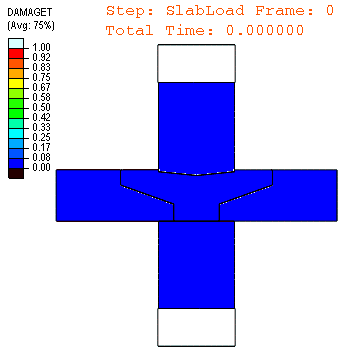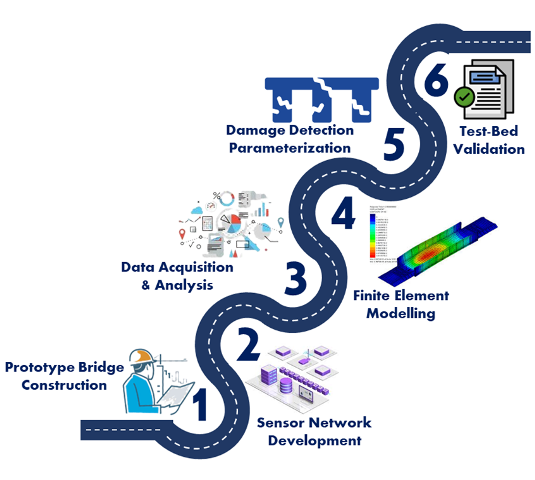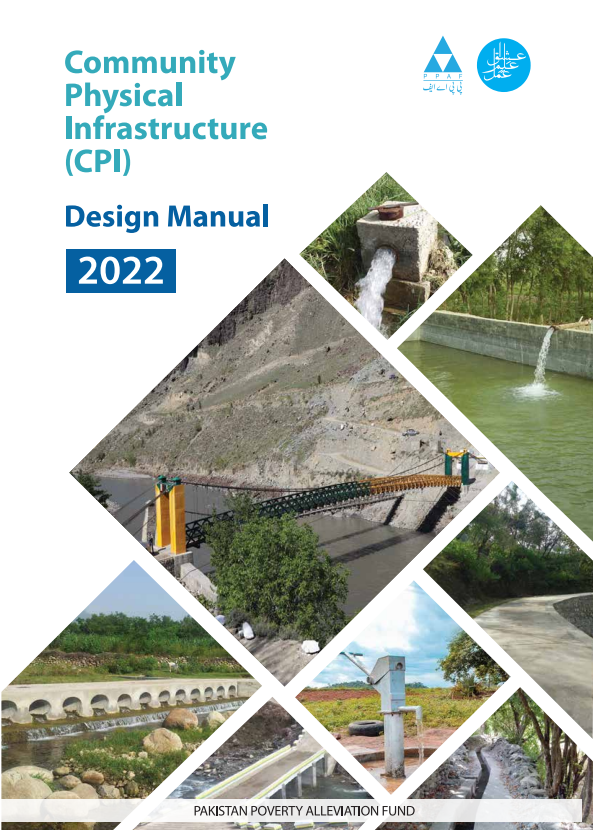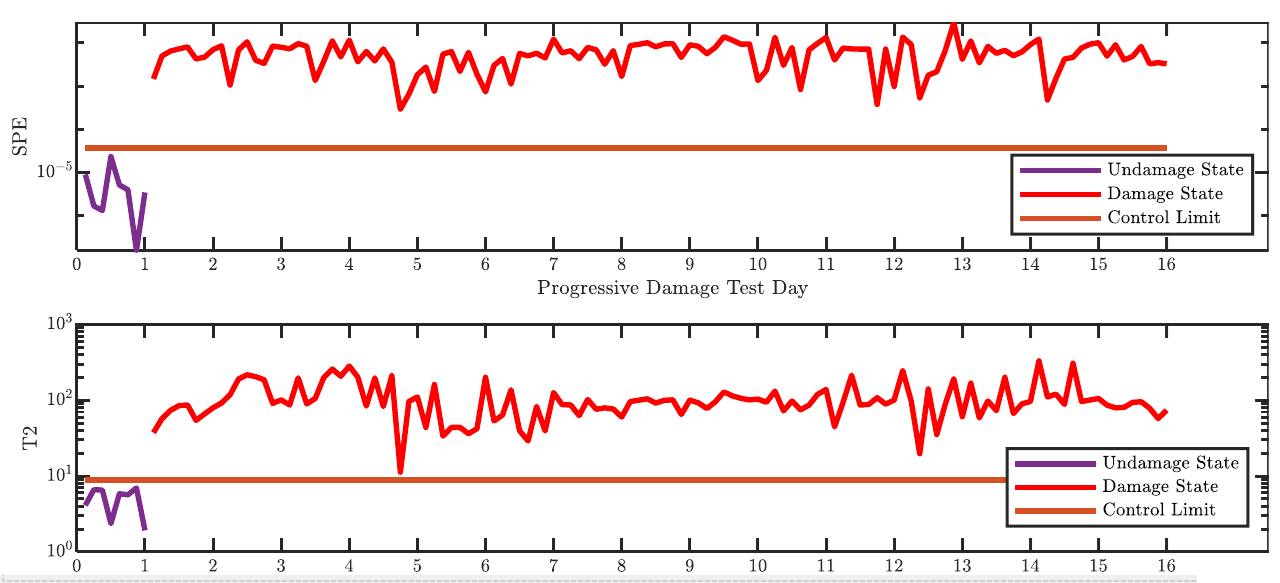Research
Current Research
Currently I am analyzing the test results from Reinforced concrete beams retrofitted using CFRP laminates performed last year. The research focuses on localizing, characterizing and realtime monitoring of the CFRP bond behavior with RC beams. We are also working on source localization using DT maps.
I have also started to investigate the mechanical properties of 3D printed concrete.
I am also preparing to apply for research projects focused on damage-assessment / structural-health-monitoring of reinforced concrete structures.
Previouos Projects

Numerical Investigation of horizontal joint failure mechanism in precast large panel structures
Progress: 100%
Introduction: Use of large panel structural systems is an old construction system and has not been much adopted. However, due to the durability of these systems in Europe, the countries with minor to none seismic activities are adopting this construction system because of the possibility of the resuability for sustainability and circularity as well as low-cost of labor. The existing design codes are developed based on local practices in US and Europe. Due to limited resources, the empirical data were obtained from the tests based on which design formulations were developed. This study uses the computational power of the advanced computers and finite element formulations to calibrate the model on existing test data. Then the parametric studies are performed to evaluate the efficacy of the existing design codes.
Objectives: Collection of the test data and review of the design procedures for large panel structures. Development of FE model and match with the test data. Conduct parametric studies. Compare design codes based on these parametric studies. Conclude which code is the most reliable for forthcoming designs.
Start Date: 2022
Duration: 1 Year

Development of testbed of a prototype bridge for real-time health monitoring of RC bridges
Progress: 70%
Introduction: Considering the lack of automation and technology in bridge health monitoring systems in pakistan to evaluate the performance of inventory bridges, challenges exist in familiarizing civil engineering industry locally with the SHM techniques. One of these challenges is the lack of monitoring equipment which costs a significant amount thus making the application of these procedures expensive. We have proposed a prototype bridge which acts as a testbed to monitor damage characteristics and the environmental influence on them. This testbed will also be helpful in developing and calibrating sensor and data acquisition technologies for application on the bridges.
Objectives: Construction of the prototype bridge, acquiring the baseline data for undamaged stage (vibration characteristics), evaluate the influence of environmental effects in the long term on sensors/structural health, and lastly, developing an automated monitoring system which helps in monitoring the strutcure in real-time
Start Date: 2022
Duration: 3 Years

Revising the current version of Community Physical Infrastructure (CPI) Construction Manual
Progress: 100%
Introduction: It was a short project of updating the existing construction manual. The existing manual was aimed at supporting the local communities to manage their infrastructure on their own with very basic engineering knowledge. The task was to transform complex design calculations into design charts which could be used safely by them for the construction of simple structures like houses, water tanks, retaining walls, roads, irrigation systems and bridges
Objectives: Revising the existing design provisions in accordance with the building codes, Simplify the design and provide design charts easily interpretable by the community
Start Date: 2021
Duration: 6 Months
Collaborators
-
Prof Soo-Yeon Seo
Professor
KNUT, South Korea
Reinforced concrete, composites -
Dr. Khaled Ghaedi
CEO
Pasofal Malaysia
FE Modeling -
Dr. Ahad Javanmardi
Associate Professor
Fuzhou University China
Bridges, FEM -
Atif Ahmed
Tech Lead
INTEL Malaysia
Programming, Data Analysis -
Dr. M. Usman Hassan
Associate Professor
NUST, Pakistan
Digital Twins -
Dr. Ahmad Zaki
Assistant Professor
UMY Indonesia
SHM, RC Structures -
Dr. Athar Ali
Lecturer
NUST, Pakistan
FE Modeling
Student Dissertations
Postgraduate
Degree: MSc, Authors: Hamza Ahsan Abdullah, Supervision: Athar Ali (S), Usman Hanif (Co-S), Muhammad Usman Hassan (Co-S), Awarding Institute: NUST, Pakistan
Abstract: Bridges are subjected to a variety of loads throughout their service life, including service loads, seismic events, and environmental forces, which may compromise their structural integrity. As these structures are significant and expensive assets, there is a growing emphasis on using advanced structural health monitoring (SHM) techniques to ensure their safety and longevity. This research introduces a refined approach for the precise detection of damage in bridges using state-of-the-art signal processing methods. In the initial phase, ambient vibration data are captured via accelerometers strategically installed on the bridge to record its response in healthy state for baseline data. Vibrations data are then processed using Complete Ensemble Empirical Mode Decomposition with Adaptive Noise (CEEMDAN) to extract intrinsic mode functions (IMFs). These IMFs are used for signal reconstruction followed by further analysis thorough Empirical Wavelet Transform (EWT). This combination efficiently segregates the bridge vibrations into distinct modes, thereby enhancing the identification of potential damages by mitigating noise interference and closely spaced frequencies. The spectral centroids (SC) of these modes are computed using Short-Time Fourier Transform (STFT) to serve as critical damage-sensitive features. Subsequently, an artificial intelligence model utilizing Kernel Principal Component Analysis (KPCA) is employed. This model is trained on baseline data to establish control limits and then used to detect deviations in new datasets by analyzing changes in the Squared Prediction Error (SPE) and Hotelling’s T2 statistic, it enables effective damage detection. The efficacy of this methodology is empirically validated using real-world data collected from the Z-24 bridge, demonstrating its practical applicability and reliability. Additionally, an RC-bridge health condition was also monitored to detect any potential damage. The innovative integration of CEEMDAN, EWT, and KPCA in this research offers a robust framework for early damage detection, promising significant improvements in the maintenance and monitoring of bridge structures, the efficiency of which was validated through performance metrics.

Degree: MSc, Authors: Senghong Khol, Supervision: Prof Soo-Yeon Seo (S), Usman Hanif (Co-S), Awarding Institute: Korea National University of Transportation, South Korea
Abstract: Shear strengthening of reinforced concrete beams using near-surfac mounting (NSM) method with CFRP strips is more effective compared to Externally Bonded Reinforcement (EBR) method because of improved bond strength, better fire resistance and high maintainability. However, during groove work for NSM reinforcement, it may not be easy for the rotating blade of the processing equipment to access the beam-slab edge. Consequently, the application of NSM method becomes more difficult to apply. Therefore, in this study, the effect of reducing in NSM length on the shear strength has been investigated by reinforcing only a part of the height, not the entire web of beam, referred to as the partial-length NSM method (PLNSM). Five RC T-beams were made and tested under symmetrical four-point static loading system. All except one was strengthened in shear in which the effect of reduced NSM length was balanced by inclining the partial-length NSM strips (IPLNSM) or by combining the NSM method with EBR method. Additionally, due to the brittle failure of shear strengthening with CFRP, Non-destructive Acoustic Emission (AE) techniques were carried out to monitor damage progress of three strengthened specimens. The results showed that there was no significant negative effect of reduced NSM length on the strength of the strengthened specimens, and by providing inclined NSM strips, significant improvement in the strength was observed. Furthermore, the hybrid approach combining inclined partial-length NSM (IPLNSM) and the EBR method showed improved strength and deflection capacity. Lastly, when compared with the currently available design procedures, it was found that the Nanni et al. (2004) formulation can predict the design strength of PLNSM and IPLNSM reinforcement, thus making them a viable option for retrofitting reinforced concrete beams. Moreover, AE source location can be used to monitor the initiation of cracks, crack propagation, and damage localization. The damage occurrence can be monitored using energy, while debonding of CFRP sheet can be characterized by using cumulative hit and peak frequency range of 200-300 kHz.

Degree: MSc, Authors: Sultani Mulk Khan, Supervision: Usman Hanif (S), Azam Khan (Co-S), Awarding Institute: NUST, Pakistan
Abstract: Acquisition of vibration data using off-the-shelf equipment is a costly procedure, thus constraining the research and development in developing countries. In this research, micro-electromechanical systems (MEMS) accelerometers combined with an Arduino-based data acquisition system, were used to acquire vibration data of a reinforced concrete beam at various damage levels. The recorded data, having lower and varying sampling frequency, were processed to find the fundamental frequency of the beam. The results showed good agreement with the commercially available accelerometers. To integrate the experimental and computational work, a finite element model was developed which showed good agreement with the experiment. It was found that MEMS accelerometers are cost-effective and can be effectively employed for continuous health monitoring of existing civil infrastructure.

Degree: MSc, Authors: Abdul Rehman Shafiq Mughal, Supervision: Usman Hanif (S), Rao Arslan Khushnood (Co-S), Awarding Institute: NUST, Pakistan
Abstract: All structures, as well as crucial civil infrastructure facilities like bridges and highways, deteriorate with time because of varied reasons as well as fatigue failure caused by repetitive traffic masses, effects of environmental conditions, associated extreme events like an earthquake. This needs not simply routine or critical-event based mostly inspections (such as associate earth-quake), however a means of continuous monitoring of a structure to provide an assessment of changes as a function of time and an early warning of an unsafe condition using real-time data. Thus, the health watching of structures has been a hot analysis topic of structural engineering in recent years. Therefore, there is a need to develop a damage detection method which can identify most of the damages in RC structures. The main objective of this research is to model and simulate damage in RC beam with the aid of finite element software, ABAQUS. In order to achieve this goal, material modelling was carried out. Concrete Damaged Plasticity (CDP) model was used to simulate failure of concrete beams. Static and dynamic analysis were simulated with the aid of ABAQUS. The validation of the numerical model was made through literature data, including static and dynamic testing of RC beams. The relationships between load and deflection, damage level and natural frequency were discussed. The comparison between the results of the numerical model from ABAQUS and literature data showed a similar trend in deflection and damage levels. Furthermore, an insight on non-linearities as damage indicators has been simulated. These damage indicators have been simulated and experimentally proved and have promising prospects in damage detection of structures without the need of baseline data. The research requires to be extended to identifying more non-linear characteristics.

Undergraduate
Degree: BSc, Authors: Hussain Ahmad Sheikh, Sadam Hussain, Asad Nadeem, Muhammad Usman, Supervision: Usman Hanif (S), Awarding Institute: NUST, Pakistan
Abstract: Recently the use of vibrating wire strain gauges has increased to find out the damage in a reinforced concrete structure. The assembly and functioning of this acoustic strain gauge are presented. This gauge provides numerous benefits including its sensitivity to measure strain (up to 1micron) and its property of being easily attached on any concrete surface. The gauge apparatus can be made in a lab due to its low cost which gives it an edge over the conventional systems. The gauge was calibrated after considering the variations in temperature. The purpose of the experimentation was to record the changes in nonlinear vibrations with respect to the damage caused in the reinforced concrete member. These changes were later studied using the vibration tests on the reinforced concrete beam. Nonlinearities were observed by the changes in the fundamental frequency. Discrete Fourier transforms moving window was utilized to analyze the vibration signals specifically the change in frequency with respect to time. The results are presented and reviewed.

Degree: BSc, Authors: Muhammad Mubeen, Hamza Naveed, Qudees Tariq Kayani, Supervision: Usman Hanif (S), Awarding Institute: NUST, Pakistan
Abstract: The Airport infrastructure including approach runways, taxiways, and aprons is the most important and extremely sensitive target to be attacked by the enemy during warfare. Damage to airfield pavements from sophisticated enemy munitions threatens sustained aircraft sorties until the airfield is repaired. Bombing infuses large craters into the airfield infrastructures approaching 20 feet in width. Timely repair to immediately resume the flight operations is the topmost concern of the scenario. Numerous research in terms of materials, equipment, and techniques are globally practiced in the backfill of craters followed by the placement of crown as prefabricated modular elements or in-situ repair with rapid setting and rapid hardening grout. However, there are multiple associated parameters with local conditions that enforce an optimized solution for a particular site. The project aims to analyze all the available alternatives to extract an optimal solution for the restoration of airfields back on operational status following an enemy attack. In this study, Gene Expression Programming (GEP) was used to derive a predictive model of One-Day Compressive Strength of Rapid Hardening Concrete (RHC) mixes. The first objective of developing a database was achieved by doing an extensive literature review of the internationally published research studies. The database contains 115 different data points of 13 numerical variables. Randomly shuffled, 74% of the data was used for the training of the GEP model while the remaining 26% of data was utilized for the validation of the model. GeneXproTools 5.0 were used in our analysis. GEP Regression Analysis was used with function finding analysis in GeneXPro tools. Various quantitative and qualitative were observed during the analysis i.e., R-Squared Value, Mean Absolute Error (MAE), regression plot, residual plot, variable importance, etc. GEP was observed to be an excellent tool in evaluating and constructing statistical models for the compressive strength of RHC. The derived models can be used in the practical pre-planning phase and pre-design phase in terms of a wide range of cementitious materials, admixtures, and additives.

Degree: BSc, Authors: Hamza Tariq, Mudassir Ahmad, Ghufran Ahmad, Waleed Afzal Khan, Supervision: Usman Hanif (S), Awarding Institute: NUST, Pakistan
Abstract: Visual inspections are the initiating procedures for any structural health assessment method. In civil engineering structures, visual inspections become more because of the massiveness of the structures. In case of bridges, which are constantly exposed to dynamic loads (such as wind and traffic loads), the health inspection procedures involve heavy machinery which involves, disrupting the traffic flow. This research was aimed at addressing the said challenge by using Building Information modeling and 3D reconstruction technique, which not provide data for visual inspection, but also provides a 3D finite element model for static or dynamic analysis. During our field data collection, we identified the constraints of carrying out the research (weather conditions). Geometric dimensions were measured as a reference for scaling the 3D model. A 4k camera mounted on a drone was used to acquire image data of the bridge using standard procedures (photogrammetry). However, due to difficulty in operating the drone in closed spaces, the procedure was supplemented by using a smartphone camera at those places. 3D reconstruction, which is the process of acquiring a 3D model based on the raw data, 3DF Zephyr and Agisoft Metashape were used. The reconstruction process resulted in two components that make up the 3D Model: Point Cloud (a) and Mesh Model (b) types of models were developed i.e. the manual model as well as the automated model. The manual model(c) was traced by using the Point Cloud as a reference, drawing the BIM model of the bridge in Revit and then using it as a reference to make the structural model in Abaqus. The automated model(d) was generated by converting the texture mesh into a solid body and was imported directly in Abaqus. Both models were analyzed using 1D modal analysis after assigning material properties. The resulting dimensions acquired from the Photogrammetric method corresponded to actual dimensions of bridge and the result of the modal analysis matched with the reference paper which showed that 3d reconstruction has great potential in its applications in civil engineering.

Degree: BSc, Authors: Talha Naveed, Muhammad Jahangir, Ahmad Rehan Kashif, Supervision: Usman Hanif (S), Awarding Institute: NUST, Pakistan
Abstract: Fictitious crack model is very suitable for modeling the fracture mechanism of concrete. This research adopts the fictitious crack model for analytical simulation of fracture mechanism of concrete. The iterative model was applied on developing moment-curvature of a reinforced concrete beam using a MATLAB code. Further efforts were made to transcribe the dynamic parameters using FCM.

Degree: BSc, Authors: Farooq Ahmed Athar, Supervision: Assoc. Prof Zainah Ibrahim (S), Usman Hanif (Co-S), Awarding Institute: University of Malaya, Malaysia
Abstract: Utilizing a large numbers of specimens in full-scaled experimental testing to study the behaviour of precast concrete connections can be expensive. An alternative is to cast and carry out a minimal number of experimental tests and then model the connection/structure in a finite element software. The FE model can be validated using the few experimental tests carried out, and FEA can be used to analyze and study the behaviour of the structure. Once validated, further parametric study can be carried out on the FE model. However, the modelling of precast concrete column-to-beam connection has not been explored widely by researchers. One of the main challenges is that modelling precast concrete connection involves complex surface to surface interaction and there is a lack of efficient ways on the modelling of the precast and in-situ concrete surface to surface interaction in finite element software. Hence, the main objective of this research is to model a hidden corbel precast beam-to-column connection in a finite element software, ABAQUS, which is then validated using the proposed precast connection and experimental works by Mokhtar (2017). Initially, the FE model was develop based on the technical drawings of the components and assembly of the precast connection. The FE model is validated when it can simulate similar structural behavior as the experimental tests. The behavior that were used for comparison with the experimental work is the moment–rotation, load–displacement, and the failure cracks patterns’ behavior. In general, the FE model results show similar behaviour with the experimental results, particularly on the load-displacement curve and failure cracks patterns. In addition, using the fixity factor, the connections were also classified as semirigid joint.

Degree: BSc, Authors: Loginy A/P Loganathan, Supervision: Assoc. Prof Zainah Ibrahim (S), Usman Hanif (Co-S), Awarding Institute: University of Malaya, Malaysia
Abstract: To perform and improve the material modelling of concrete, an existing Concrete Damaged Plasticity Model (CDPM) is incorporated into a simple concrete model in finite element software ABAQUS. The stress-strain graph of the model under compression is plotted. Then, a User-Defined Material (UMAT) coding is created using the same data and incorporated into the ABAQUS model to check the validity of the coding by plotting the same graph. Once the UMAT code is proven to be valid, the intermediate parameters and data will be modified to produce a smoother graph similar to the theoretical graph. Then, the new graph is validated using the theoretical graph. The accuracy of the ABAQUS modeling has been evaluated by comparing the stress-strain curves of the concrete proposed by Carreira and Chu to the corresponding one obtained from the numerical simulation using ABAQUS software. The verification of results show a well-agreement between the stress-strain curves of Carreira and Chu and analytical model. The significance of performing analysis on concrete using Concrete Damaged Plasticity Model is to predict formation of cracks in concrete beams under any kind of load and analyse the failure of concrete structures. As a result, cracks on beams in the future and at hidden places can be assessed. In conclusion, Concrete Damaged Plasticity Model is an easier and economical method to model concrete structures and assess its safety and functionality.

Degree: BSc, Authors: You Xian Hang, Supervision: Assoc. Prof Zainah Ibrahim (S), Usman Hanif (Co-S), Awarding Institute: University of Malaya, Malaysia
Abstract:

Degree: BSc, Authors: Huan Xin Lim, Supervision: Assoc. Prof Zainah Ibrahim (S), Usman Hanif (Co-S), Awarding Institute: University of Malaya, Malaysia
Abstract: Concrete has been known as the most common construction material for civil engineering structures. Due to the complex mechanical properties of concrete, damage detection has become a great challenge for existing infrastructure. The structural health monitoring activities are performed to detect damage to mitigate risks, prevent disasters, and plan maintenance activities to ensure sufficient safety and reduce costs of repairs. Reinforced concrete (RC) consists of a combination of materials; concrete and reinforcing steel. This combination of materials makes the analysis of failure mechanisms more challenging. Therefore, there is a need to develop a damage detection method which can identify most of the damages in RC structures. The main objective of this research is to model and simulate damage in RC beam with the aid of finite element software, ABAQUS. In order to achieve this goal, material modelling was carried out. Concrete Damaged Plasticity (CDP) model was used to simulate failure of concrete beams. Static and dynamic analysis were simulated with the aid of ABAQUS. The validation of the numerical model was made through laboratory testing, including static and dynamic testing of RC beams. The relationships between load and deflection, damage level and natural frequency were discussed. The comparison between the results of the numerical model from ABAQUS and laboratory testing showed a similar trend in deflection and damage levels. Furthermore, an insight on non-linearities as damage indicators has been simulated. These damage indicators have been simulated and experimentally proved and have promising prospects in damage detection of structures without the need of baseline data.
